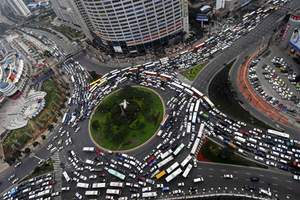 Here’s Top 10 list you don’t want your city to be on, but it could have a silver lining if you’re looking at a zero emissions or near-zero emissions car. The researchers at Texas A&M Transportation Institute (TTI) compiled their annual ranking of the worst cities in the U.S. in which to try to drive somewhere. This study year (2011) they also added another metric to those of extra time expended, added cost and wasted fuel – CO2 emissions added by congestion. Their list of the worst major cities in which to drive contains most of the usual suspects:
Here’s Top 10 list you don’t want your city to be on, but it could have a silver lining if you’re looking at a zero emissions or near-zero emissions car. The researchers at Texas A&M Transportation Institute (TTI) compiled their annual ranking of the worst cities in the U.S. in which to try to drive somewhere. This study year (2011) they also added another metric to those of extra time expended, added cost and wasted fuel – CO2 emissions added by congestion. Their list of the worst major cities in which to drive contains most of the usual suspects:
1. Washington D.C.
2. Los Angeles (tie)
2. San Francisco-Oakland (tie)
4. New York-Newark
5. Boston
6. Houston
7. Atlanta
8. Chicago
9. Philadelphia
10. Seattle
The “good” news, if you can call it that, is that this year’s congestion measurements found about the same level of traffic frustration as last year, although the improving economy is expected to put that in the rear view mirror when 2012’s numbers come out. The other bad news is the statistical significance of the difference in time spent idling in these cities is relatively little. And quite a few cities are just bubbling under the Top 10, including Miami, Dallas, Detroit, Nashville, Denver, Las Vegas and Portland. In other words, it’s slow-going out there. As TTI said in their press release announcing the report, “As traffic congestion continues to worsen, the time required for a given trip becomes more unpredictable.” Some cities are likely to seize on this report as a rationale to attempt to mitigate congestion and the attendant human and financial cost by introducing special zones designed to limit congestion and reduce greenhouse gas emissions. London did so several years ago and several other cities have followed suit. In London, since 2003, extra fees have been charged to drive into the downtown area, with exemptions for low or zero-emission vehicles. The charge has resulted in lighter traffic and reduced pollution while it has also raised revenue for the city. These “Top 10” cities are the most likely to attempt similar measures with similar goals, which could put owners of zero or near-zero emission vehicles at an advantage. Typically, they would escape any fees and/or be allowed to drive in zones that would otherwise limit traffic. It’s a logical extension of the perks extended to plug-in vehicles – some cities and states allow free parking, solo driver access to carpool lanes as well as financial incentives. Published Feb. 23, 2013

0 thoughts on “Top 10 Worst Traffic Cities; They Need Congestion-Pricing/Zero Emission Travel”